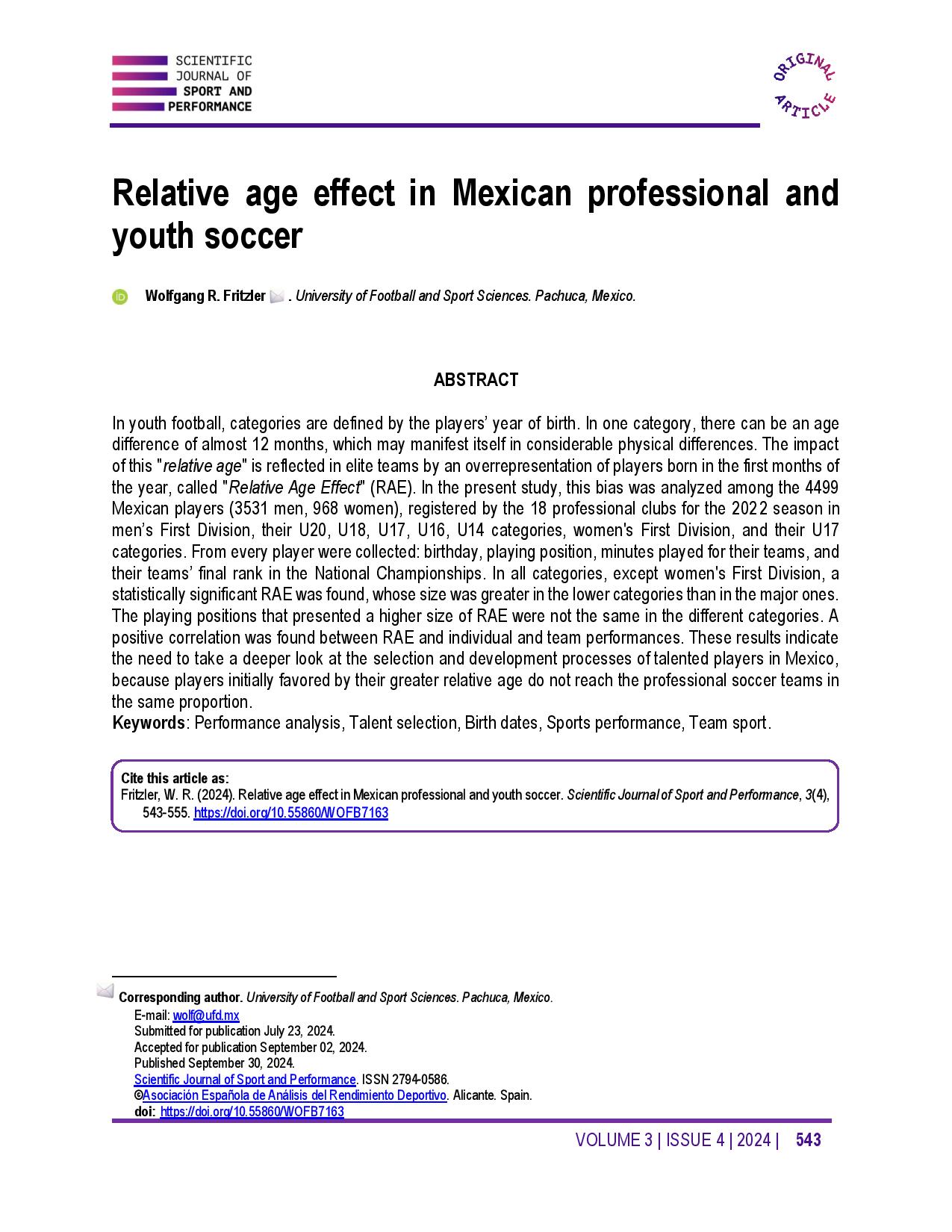Relative age effect in Mexican professional and youth soccer
Main Article Content
Abstract
In youth football, categories are defined by the players’ year of birth. In one category, there can be an age difference of almost 12 months, which may manifest itself in considerable physical differences. The impact of this "relative age" is reflected in elite teams by an overrepresentation of players born in the first months of the year, called "Relative Age Effect" (RAE). In the present study, this bias was analyzed among the 4499 Mexican players (3531 men, 968 women), registered by the 18 professional clubs for the 2022 season in men’s First Division, their U20, U18, U17, U16, U14 categories, women's First Division, and their U17 categories. From every player were collected: birthday, playing position, minutes played for their teams, and their teams’ final rank in the National Championships. In all categories, except women's First Division, a statistically significant RAE was found, whose size was greater in the lower categories than in the major ones. The playing positions that presented a higher size of RAE were not the same in the different categories. A positive correlation was found between RAE and individual and team performances. These results indicate the need to take a deeper look at the selection and development processes of talented players in Mexico, because players initially favored by their greater relative age do not reach the professional soccer teams in the same proportion.
Article Details

This work is licensed under a Creative Commons Attribution-NonCommercial-ShareAlike 4.0 International License.
References
Andrew, M., Finnegan, L., Datson, N., and Dugdale, J. H. (2022). Men are from quartil one, Women are from? Relative Age Effect in European Soccer and the influence of Age, Success, and Playing Status. Children, 9, 1747. https://doi.org/10.3390/children9111747 DOI: https://doi.org/10.3390/children9111747
Augste, C.and Lames, M. (2011). The relative age effect and success in German elite U17 soccer teams. J Sport Sci, 29(9), 983-987. https://doi.org/10.1080/02640414.2011.574719 DOI: https://doi.org/10.1080/02640414.2011.574719
Barnsley, R. H., Thompson, A. H., and Barnsley, P. E. (1985): Hockey success and birthdate: the relative age effect. Canadian Association for Health, Physical Education and Recreation Journal, 51, 23-28.
Brustio, P. B., Modena, R., Boccia, G., Vogliazzo, M., and Kelly, A. L. (2023). Youth-to-senior transition in women's and girls' football: Towards a better understanding of relative age effects and gender-specific considerations. PLOS ONE, 18(5). https://doi.org/10.1371/journal.pone.0283781 DOI: https://doi.org/10.1371/journal.pone.0283781
Daniel, W. W. (1995). Bioestadística. Base para el análisis de las ciencias de la salud. Limusa.
Figueiredo, L., Gomes, L., Da Silva, D., Gantois, P., Fialho, J., Fortes L., and Fonseca, F. (2022). The Relative Age Effect in Brazilian Elite Soccer Depending on Age Category, Playing Position, and Competitive Level. Hum Mov, 23(2), 112-120. https://doi.org/10.5114/hm.2022.109070 DOI: https://doi.org/10.5114/hm.2022.109070
González Aramendi, J. M. (2007). El efecto relativo de la edad en el fútbol. Archivos de Medicina del Deporte, XXIV(117), 5-13.
Grondin, S., Deshaies, P., and Nault, L. P. (1984). Trimestres de naissance et participation au hockey et au volleyball. La Revue Québecoise de l'Activité Physique, 2, 97-103.
Grossmann, B.and Lames, M. (2013). Relative Age Effect (RAE) in Football Talents - the Role of Youth Academies in Transition to Professional Status in Germany. Int J Perf Anal Spor, 13(1), 120-134. https://doi.org/10.1080/24748668.2013.11868636 DOI: https://doi.org/10.1080/24748668.2013.11868636
Gutiérrez Díaz Del Campo, D. (2013). Revisión y propuestas de intervención sobre el efecto de la Edad Relativa en los ámbitos educativo y deportivo. Retos. Nuevas Tendencias en Educación Física, Deporte y Recreación, 23, 51-63. https://doi.org/10.47197/retos.v0i23.34568 DOI: https://doi.org/10.47197/retos.v0i23.34568
Gutiérrez Díaz del Campo, D., Pastor Vicedo, J. C., González Víllora, S., and Contreras Jordán, O. R. (2010). Relative age effect in youth soccer players from Spain. J Sport Sci Med, 9, 190-198. www.ncbi.nlm.nih.gov/pmc/articles/PMC3761747
Helsen, W. F., van Winckel, J., and Williams, A. M. (2005). The relative age effect in youth soccer across Europe. J Sport Sci, 23(6), 629-636. https://doi.org/10.1080/02640410400021310 DOI: https://doi.org/10.1080/02640410400021310
Iglesias-Caamaño, M., Padrón-Cabo, A., and García-Soidán, J. L. (2016). Estudio del efecto de la edad relativa en jugadores de voleibol de nivel mundial. Journal of Sport and Health Research, 8(2), 163-172. Retrieved from [Accessed 2024, 18 september]: https://dialnet.unirioja.es/servlet/articulo?codigo=5569459
Isin, A. (2021). The Relative Age Effect in successful national football teams. Kinesiología Slovenica, 27(2), pp. 40-51. https://doi.org/10.52165/kinsi.27.3.40-51 DOI: https://doi.org/10.52165/kinsi.27.3.40-51
Lesma, M. L., Pérez González, B., and Salinero, J. J. (2011). El efecto de la edad relativa (RAE) en la liga de fútbol española. J Sport Health Res, 3(1), 35-46.
Martín Acero, R., Lagos, C., and Lalín, C. (2005). Efecto de la edad de los jugadores de fútbol de alto rendimiento. El entrenador español, 105, 55-61.
Musch, J. and Grondin, S. (2001). Unequal competition as an impediment to personal development: A review of the relative age effect in sport. Dev Rev, 21, 147-167. https://doi.org/10.1006/drev.2000.0516 DOI: https://doi.org/10.1006/drev.2000.0516
Salinero, J. J., Pérez, B., Burillo, P., and Lesma, M. L. (2013). Relative age effect in european professional football. Analysis by position. Apunts. Educación Física y Deportes, 114, 53-57. https://doi.org/10.5672/apunts.2014-0983.es.(2013/4).114.05 DOI: https://doi.org/10.5672/apunts.2014-0983.es.(2013/4).114.05
Sallaoui, R., Chamari, K., Chtara, M., Manai, Y., Ghrairi, M., Belhaouz, M., and Baroon, A. (2014). The relative age effect in the 2013 FIFA U-17 Soccer World Cup competition. American Journal of Sports Science, 2(2), 35-40. https://doi.org/10.11648/j.ajss.20140202.15 DOI: https://doi.org/10.11648/j.ajss.20140202.15
Vaeyens, R., Philippaerts, R. M., and Malina, R. M. (2005). The relative Age Effect in Soccer: A match-related perspective. J Sport Sci, 23(7), 747-756. https://doi.org/10.1080/02640410400022052 DOI: https://doi.org/10.1080/02640410400022052




